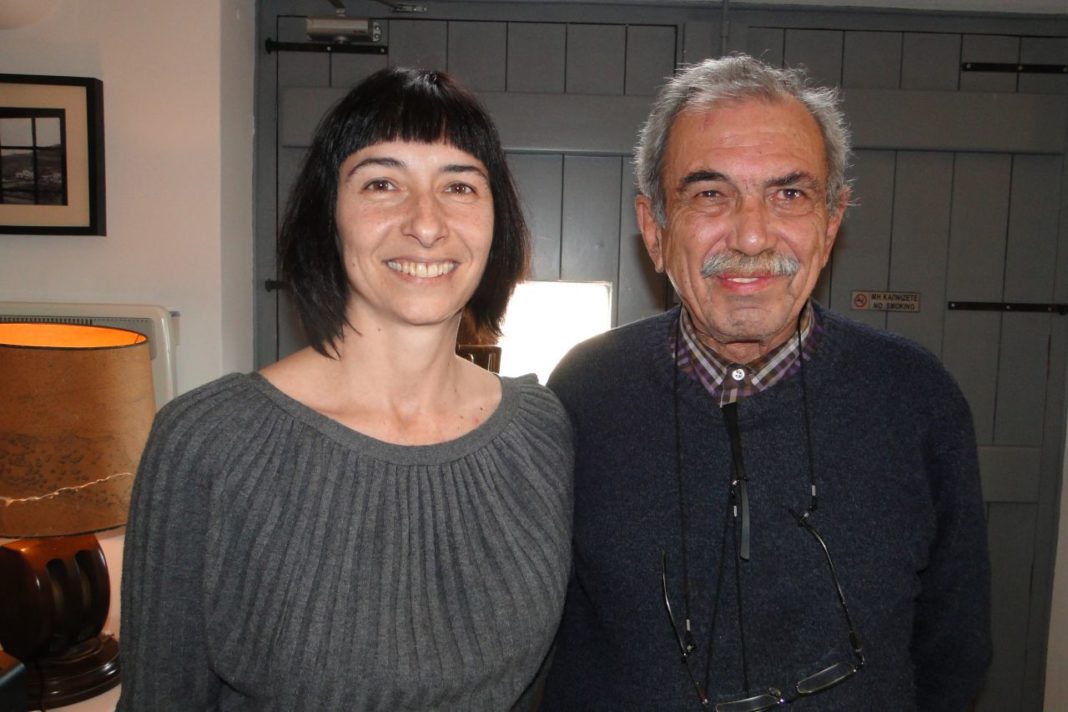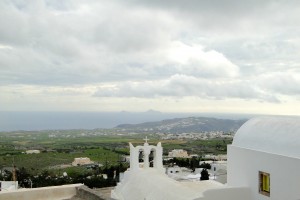by Marc d’Entremont
“Selene is zero distance from farm to table,” Georgia Tsara says with a broad smile obviously as pleased with the restaurant’s location on Santorini as she is with this fabled island’s products. The volcano that blew Santorini into history 3,500 years ago is responsible for sculpting the magnificent and photogenic 800-foot cliffs currently topped by some of the most sought after hotels in all the Greek Islands. More than a million and a half tourists annually flock to the island to enjoy its elegant cliff-clinging hotels, jaw-dropping vistas, luxury shops in the capital of Fira and its cosmopolitan restaurants.
There’s evidence that the ancient island of Thira, as Santorini was known four millenniums ago when part of the legendary Minoan civilization, had always been an agricultural powerhouse. Archaeologists unearthing the remarkably preserved ruins of Akrotiri have documented the rich life on this island prior to the massive volcanic explosion that destroyed the first great Greek state. Yet this cataclysmic disaster set in motion a combination of natural forces creating ideal conditions for agricultural products sought after throughout Greece.
Approaching Santorini by ship a visitor is first struck by the sheer size and beauty of its cliffs with towns towering hundreds of feet above the Aegean and then by the dry volcanic landscape nearly devoid of trees. The hot dry daytime temperature shifts to cool as dusk settles over the island. The rocky volcanic soil absorbs the daytime heat and, surrounded by the Aegean Sea, the humidity level rises considerably. At dusk the humidity condenses, rising up the cliffs creating fog-like conditions that, despite an average annual rainfall of only a few inches, waters the plant life overnight. “The humidity and mist keep the island from being a desert,” says Stela Kasiola, marketing manager for Santo Wines and its Union of Santorini Cooperatives.
Extensive interviews with Stela Kasiola of Santo Wines and Georgia Tsara, manager and sommelier of Selene’s – one of the top three restaurants on the island – provided an education on how, despite adversity, nature exceeds expectations. Georgia is the foremost expert on the island’s unique agriculture, coordinates and teaches many of the cooking, cheese and wine classes held at Selene and was a major force behind Santorini’s Year of Gastronomy designation in 2013. Along with Selene’s owners, Yiorgos and Evelyn Hatziyannakis, they created the cultural village museum Santorini of the Past within the restaurant complex. The museum has seven rooms detailing Santorini life including three devoted to gastronomy.
“Santorini gastronomy post explosion was vegetable based,” says Georgia. The island was only repopulated in the 6th century A.D. – 4,000 years after the eruption. Cattle could not be raised. Eventually residents were able to maintain a few goats providing meat and milk and a pig, which was consumed nose to tail as well as using its fat – lard – for cooking since olive oil was unavailable. Even today, olive trees are just being introduced and most olive oil, as well as meat, is brought in from other islands and the mainland. Birds and rabbits did exist providing wild game for the diet, but even fishing was difficult because of the rough deep water.
[col type=”one-fourth”]
[/col]
[col type=”three-fourth last”]
Santorini had a wine industry before the volcanic explosion and the wines were exported throughout the Minoan civilization. During its repopulation after the 6th century, Santorini wine again gained prominence even being favored by the Russian Orthodox Church. Part of the Venetian Empire in the Middle Ages, the sophisticated cuisine of that city strongly influenced the island and, according to Georgia Tsara, is still evident in upscale island restaurants today.
Pezoules, terraced farming, is the method of choice in many Mediterranean climates. It conserves nutrient poor mountain soil from erosion while minimizing moisture evaporation due to wind. Yet all of Santorini’s climate limitations maximize the quality of its vineyards. According to Stella Kasiola, “the dry volcanic soil’s intense mineral content, low ph, high acidity and salinity” directly contributes to producing the dry whites for which the island is famous.
[/col]
The vineyards themselves look different from most others on Earth. The kouloura is the unique way of pruning the grape vines to keep the round shape of a basket-like circle. The grapes grow into the basket, protected from the strong winds and the hot sun. Hugging the ground, the vines absorb the night mist and draw more efficiently on the ground’s precious moisture.
Yet nature nearly destroyed the island in the 20th century. Major earthquakes in 1956 and the fear of another eruption forced the virtual abandonment of Santorini for 25 years. By the 1980s many original families returned along with real estate investors. With land prices soaring, many farmers sold out to developers and tourism swept the island. Cultivated acreage declined by 65%.
Founded in 1947 after the devastating effects of the Second World War on agricultural production, The Union of Santorini Cooperatives, now faced with an even greater challenge, refocused its mission”to preserve the cultivation of land and overcome the challenge of rapid touristic development that leads to the abandonment of land cultivation.” The largest farm co-op on the island with approximately 2,500 members, it has under its umbrella 3,200 acres of vineyard, 600 acres of Santorini fava beans and 125 acres of Santorini tomato farms, comprising over 17% of the most tourist developed island in Greece. The co-op maintains European Union certificates in all areas protecting food safety, quality and indigenous agricultural products.
The Santorini tomato is small. Its thick skin protects a velvety firm flesh concentrating the natural sugars to produce a fruit with intense aromas and a sweet taste. Georgia explained that the Santorini tomato provided major income for farmers from its paste until 1956. Now, due to limited available acreage, it’s only because of The Union of Santorini Cooperatives that the paste is still produced. The growing season is short, June through September, but each plant is capable of producing three crops.
The Santorini fava bean has a high nutritional value rich in proteins – 20% protein per 100 grams. Santorini fava is a type of yellow lentil. In June the entire plant is uprooted and dried. After the bean is removed from the pod it ages for one year. Then the outer shell of the bean is removed, and the bean is cut in half. The cost is over $10 per pound. Only five farmers on the island are commercial growers of fava and demand exceeds supply. The beans are primarily used for an appetizer puree much sought after by both home kitchens and restaurants.
The wild caper bush grows in the gaps of rock walls and outcroppings. High in vitamns and antioxidants, both the berry and the leaves have intense flavor and are usually preserved to be used in all manner of dishes.
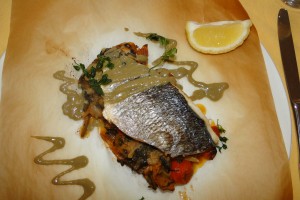
White eggplant came over from Egypt in the 13th century. The plant requires little water to grow, is nearly seedless and not bitter, therefore salting to leech out bitter juices is unnecessary. Georgia said it’s even used in desserts!
Santorini zucchini is round, the size of a baseball. It can be eaten raw with herbs and oil in a salad or cooked like any other zucchini. It’s sweeter that other varieties and crisp, like a cucumber, when raw.
Along with Santorini garlic, aromatic and intense, all these agricultural products are certified and protected by European Union regulations. Of course, the same applies to the islands indigenous grapes – the white varieties of assyrtiko, athiri, aidani and the red mandilaria and marvrotragano.
All this education created an appetite, and tucking into the dishes of Selene Bistro’s Chef Thodoris Papaniklaou was a delight. Selene opened in 1986 in Fira. From the start it worked with local farmers promoting Santorini products but with a menu that tweaked tradition. Eventually Yiorgos and Evelyn Hatziyannakis relocated to the medieval and architecturally protected hilltop village of Pyrgos far from the madding crowds of tourists and closer to the farms – four miles from Fira (there are no great distances on the islands). Consisting of two restaurants in a complex of restored Pyrgos structures, fine dining Selene opens May through November, but the Bistro, in a restored stone barn, is open all year noon to 11:00 p.m.
An aperitif of Amalia Brut naturally sparkling wine was pleasantly dry with a citrus nose and a mouth of grapefruit and lemon peel. Consistent small bubbles rose in the glass tickling the palate.
The Amalia Brut paired perfectly with paper-thin slices of carpaccio of sea bass napped with olive oil and red peppers. Modern fishing methods have allowed the islanders to take advantage of the rich marine life surrounding Santorini from swordfish to anchovies. The dish was garnished with kardamides, a peppery/spicy wild green herb that is gathered in springtime and traditionally served with fish dishes.
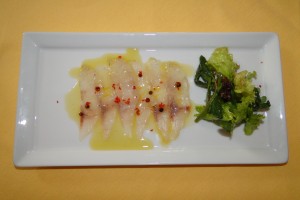
An imaginative potato salad topped with salt cod and capers defined the new wave of Greek cuisine tweaking traditional ingredients for the 21st century. The salt cod added depth of flavor yet the potatoes mitigated any lingering saltiness. The cod was soaked in milk for up to four hours and lightly steamed, becoming soft and velvety. Santorini capers added their nutty herbal flourish to the dish.
Dorado fillet baked in parchment over a medley of vegetables drizzled with caper sauce melded the flavor essences of the island. For the caper sauce soak capers in water to remove some of the salt. Puree in a blender and slowly add olive oil to make a sauce of mayonnaise consistency.
A small fillet of dogfish arrived nestled in a sauce of burnt clarified butter, capers, chickpeas and cream. An intense, almost bitter, fresh flavored lemon foam topping was an airy counterpoint to the rich sauce. Perfectly executed, the foam never deflated while eating the dish. Each flavor remained distinct, even the chickpeas maintained their nuttiness, yet the blend was in harmony.
A Santorini assyrtiko, one of the finest dry white wines on the planet, complimented this fish centric lunch.

A creamy semi-sweet Greek coffee mousse with an intense coffee flavor was garnished with chocolate shavings and accompanied by the prize of Santorini wines – Vinsanto.
An ancient wine that spread throughout the region during the medieval era of Venetian power, Vinsanto is a blend of 85% assyrtiko and 15% aidani grapes. But its unique flavor comes from sun drying the grapes for two weeks before mashing and aging in French oak from 3 to 20 years. The result is a rich, smooth, deep amber dessert wine with a nose of raisins, then lemons, with these flavors continuing in the mouth. The longer the Vinsanto ages the more intense the flavors adding caramel and butterscotch notes in the oldest varieties. Vinsanto pairs well with honey and cream based desserts, nuts and cheese.
I wandered the steep narrow streets of ancient Pyrgos after lunch past the crumbling medieval fortress and restored townhouses. Roosters crowed and the panorama of this storied island was always in view. It defined the continuum of Greece – millenniums of civilization bound tight by family and food.
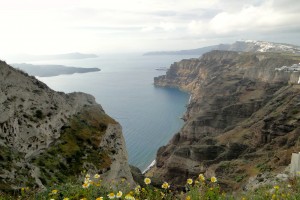
Selene Restaurant, Pyrgos, Santorini, Greece
Phone: +30 22860 22249
Fax: +30 22860 24395
email:[email protected]
web: https://www.selene.gr
Santo Wines, Pyrgos, Santorini, Greece
Phone: +30 22860 22596
Fax: +30 22860 23137
email: [email protected]
web: www.santowines.gr
Note: Santo Wines sells all products produced by The Union of Santorini Cooperatives at their Oenotourism Center. Visitors can enjoy extensive wine tastings and breathtaking views.





